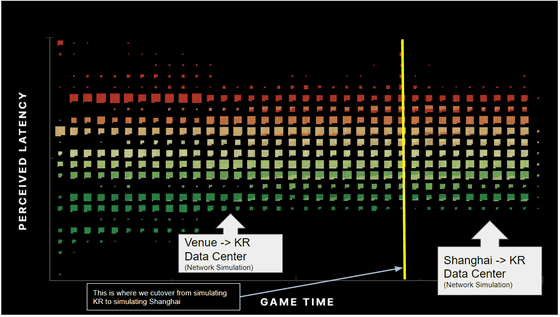Riot Games of 'League of Legends' has developed a tool to artificially generate delays and equalize pings, and there is a possibility that there will be no disadvantage due to delays even if you participate remotely in official e-sports competitions

Riot Games, the developer and operator of '
Riot Games Tech Blog: Artificial Latency for Remote Competitors
https://lolesports.com/article/riot-games-tech-blog-artificial-latency-for-remote-competitors/blt44154a33b5d5a616
Riot Games is hosting the official League of Legends tournament, the 2022 Mid-Season Invitational , from May 10th to 29th, 2022. League of Legends gaming teams from all over the world came to the tournament, but China's professional gaming team RNG (Royal Never Give up) will participate in the tournament remotely. Riot Games esports-related technology teams will equalize player pings to ensure that there is no inequity between remote tournament RNGs and local tournament teams. We have developed a tool.
Riot Games says, 'In the case of the League of Legends competition scene, the delay fluctuation is about plus or minus 5 milliseconds (ms), and the upper limit of ping that can be tolerated in the top level competition scene is 40 ms. , I planned to equalize the pings of all players to '35ms'. ' Riot Games has developed a latency service that artificially creates delays to equalize pings. Some development teams call this latency service 'fake ping'. This latency service will cause a delay in the player's client and server as needed to unify the player's ping to 35ms.
It seems that this latency service was originally a tool used in e-sports events, but since it is a tool that has been used only in events that are held completely remotely, it is like this at a real event held locally. Introducing latency services was the first challenge for Riot Games.
Riot Games' latency service is built into the League of Legends native client and server network stack to continuously measure network delays between players and servers to ping their targets. Insert any delay. This latency service is built into both the client and server solutions, so it tries to even out the latency on both sides of the network.
The figure below briefly describes the operation of the latency service. 'Game Server' represents the game server, 'Player' represents the game client for each player, and 'Delay' on both the server and the client. ) ”Represents the delay intentionally generated by the latency service. The red arrow is the actual ping between the server and the client, and the yellow arrow is the ping after applying the latency service.

Riot Games used this latency service to ping all players to 35ms at the 2022 Mid-Season Invitational. However, when I actually used it, it became clear that there was a bug that caused excessive pings to the players participating in the tournament at the venue.
The figure below summarizes the delay when playing League of Legends from the venue (left) and the delay when playing League of Legends from outside the venue (Shanghai) (right). The horizontal axis represents the game play time, and the vertical axis represents the delay that is occurring. If you have disabled the latency service, you will see that the player playing from Shanghai is causing the delay.

The following is a summary of the delays when the latency service is enabled and implemented. You can see that the difference in delay has narrowed considerably, but you can also see that there is a slight difference in delay. In the game played at the beginning of the tournament, it seems that there was a difference in delay as shown in the graph below.

To address this bug, Riot Games reconfigured its latency service tools on May 13th. In addition, we have decided to rematch the teams affected by the latency service tools in previous matches.
A Message from Alex François, Global Head of Competitive Operations, Riot Games
https://t.co/YIe1r2vx0c pic.twitter.com/ynVyw0wuPn — LoL Esports (@lolesports) May 13, 2022
As a result, the delay difference between the venue and the players outside the venue has become almost zero.

In addition, it became clear that the ping displayed on the screen of the player who participated in the tournament from the venue was lower than the actual value due to the adverse effect of the modification added to the latency service tool made on May 13. 'The 2022 Mid-Season Invitational viewers believed that the pings of the players attending from the venue were lower than they really are,' Riot Games wrote.
Related Posts:
in Game, Posted by logu_ii







